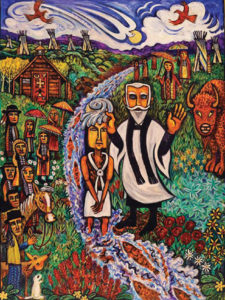“White Robe” A contemporary art exhibition by celebrated Irish artist Brian Whelan on life and work of the Rev. Dr. John Roberts of the Wind River Reservation in Wyoming.
Reverend John Roberts is one of the most significant figures in the history of the Lander Valley. A new collection of paintings by Irish artist Brian Whelan tells his life story and will displayed at the Lander Pioneer Museum this summer.
Modeled after the historic Chief Washakie paintings by J.K. Ralston that hang in the Lander Museum, the Whelan paintings tell the story of significant parts of Robert’s life.
The unique exhibition will premiere on the 140th anniversary of The Rev. Dr. John Roberts’ arrival on the Wind River Reservation in Wyoming, in 1883, where he served among the Eastern Shoshone and Northern Arapaho tribes. Beyond commemorating his extraordinary life and ministry, the exhibition also draws attention to the importance of learning from the spirituality, culture and traditions of Native Americans.
Roberts was born in Wales in 1853, and while training for Anglican ordination felt called to serve among his Native Americans in North America. Following a brief time of service within a leper colony in the Bahamas, he began his ministry on the Wind River Reservation in 1883. Not long after his arrival, he conducted the funeral for Sacagawea, who as a young Eastern Shoshone woman, was the celebrated guide on the renowned Lewis & Clark expedition. As a missionary-priest, Roberts was well ahead of his time, as he encouraged Native American expressions of spirituality and faith, embracing and honoring tribal culture and language, and traditional indigenous rituals and customs. He cultivated close friendships with tribal leaders, including the renowned Eastern Shoshone Chief Washakie and Northern Arapaho Chief Black Coal, and was referred to with deep affection as “White Robe” and "Elder Brother.” If there were negotiations with U.S. government officials, the tribes would not proceed without John Roberts being present. His work led him, with the assistance of tribal leadership, to establish two alternative schools on sacred land gifted by the tribes that focused on honoring and preserving Indigenous culture. One of the schools is on the National Register of Historic Places today.
In addition to his ministry on the Wind River Reservation, he founded all the Episcopal churches among white settlers within 150 mile radius, in Fremont County - including among others, the present-day Episcopal churches in Lander, Riverton, Thermopolis, Atlantic City, Morton, Crowheart and Dubois, and churches that no longer exist in Milford, Hudson and Shoshoni.
Brian Whelan grew up in London, of Irish parents. After his training at the Royal Academy of Arts, he lived and worked in the East Anglia area of England near the North Sea. His home and studio are now based in Connecticut, USA. Known for his folk and whimsical style, his paintings have been exhibited in celebrated art spaces, cathedrals and religious institutions around the world - such as Washington National Cathedral and Villanova University of Pennsylvania in the USA, St. Martin in the Field, Trafalgar Square, London, St. Edmundsbury Cathedral and Norwich Cathedral in the U.K., and Parador Dos Reis Catolicos, Santiago de Compostela in Spain. Whelan’s work follows in the tradition of East Anglian narrative painting.


